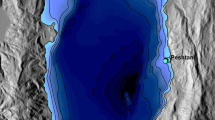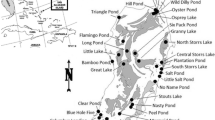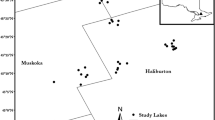Abstract
Community structure is determined by a variety of ecological mechanisms, including environmental control, dispersal, and historical contingency. Recently, many studies have focused on the relative relevance of environment and dispersal in shaping metacommunities. Historical contingency (e.g., priority effects) rarely has been considered, although it could have a key role. In this context, the use of paleoecological methods could help assess the influence of past events on the present-day communities. In this survey, we compare living ostracod assemblages (i.e., biocoenoses) and subfossil assemblages (i.e., taphocoenoses) from 22 steppic shallow lakes and determine the relative contribution of environmental and spatial components on both assemblages. In addition, we estimate the role of putative priority effects of past assemblages on contemporary ones. Our results indicate a high concordance between both assemblages (Procrustes analysis; r = 0.877; P = 0.001). However, environment dominates over space in explaining the biocoenoses, whereas in taphocoenoses space dominates over environment. Furthermore, the contemporary metacommunity structure was related not only to pure environmental and spatial effects (suggesting species sorting and dispersal constraints) but also notably to pure historical effects, suggesting a significant major role of earlier habitat occupation in these ecosystems.




Similar content being viewed by others
References
Alonso, M., 1998. Las lagunas de la España peninsular. Limnetica 15: 1–176.
Arribas, P., C. Andújar, P. Abellán, J. Velasco, A. Millán & I. Ribera, 2014. Tempo and mode of the multiple origins of salinity tolerance in a water beetle lineage. Molecular Ecology 23: 360–373.
Astorga, A., J. Oksanen, M. Luoto, J. Soininen, R. Virtanen & T. Muotka, 2012. Distance decay of similarity in freshwater communities: do macro- and microorganisms follow the same rules? Global Ecology and Biogeography 21: 365–375.
Baltanás, A., C. Montes & P. Martino, 1990. Distribution patterns of ostracods in iberian saline lakes. Influence of ecological factors. Hydrobiologia 197: 207–220.
Battarbee, R. W., N. J. Anderson, E. Jeppesen & P. R. Leavitt, 2005. Combining palaeolimnological and limnological approaches in assessing lake ecosystem response to nutrient reduction. Freshwater Biology 50: 1772–1780.
Bennett, J. R., B. F. Cumming, B. K. Ginn & J. P. Smol, 2010. Broad-scale environmental response and niche conservatism in lacustrine diatom communities. Global Ecology and Biogeography 19: 724–732.
Birks, H. H. & H. J. B. Birks, 2006. Multi-proxy studies in palaeolimnology. Vegetation History and Archaeobotany 15: 235–251.
Bivand, R. & G. Piras, 2015. Comparing implementations of estimation methods for spatial econometrics. Journal of Statistical Software 63: 1–36.
Blanchet, F. G., P. Legendre & D. Borcard, 2008. Forward selection of explanatory variables. Ecology 89: 623–2632.
Borcard, D., P. Legendre & P. Drapeau, 1992. Partialling out the spatial component of ecological variation. Ecology 73: 1045–1055.
Boronat, L., M. R. Miracle & X. Armengol, 2001. Cladoceran assemblages in a mineralization gradient. Hydrobiologia 442: 75–88.
Brochet, A. L., M. Gauthier-Clerc, M. Guillemain, H. Fritz, A. Waterkeyn, Á. Baltanás & A. J. Green, 2010. Field evidence of dispersal of branchiopods, ostracods and bryozoans by teal (Anas crecca) in the Camargue (southern France). Hydrobiologia 637: 255–261.
Brothers, S., J. C. Vermaire & I. Gregory-Eaves, 2008. Empirical models for describing recent sedimentation rates in lakes distributed across broad spatial scales. Journal of Paleolimnology 40: 1003–1019.
Çakıroğlu, Aİ., Ü. N. Tavşanoğlu, E. E. Levi, T. A. Davidson, T. Bucak, A. Örzen, G. K. Akyıldız, E. Jeppesen & M. Beklioğlu, 2014. Relatedness between contemporary and subfossil cladoceran assemblages in Turkish lakes. Jounal of Paleolimnology 52: 367–383.
Camacho, A., M. R. Miracle & E. Vicente, 2003. Which factors determine the abundance and distribution of picocyanobacteria in inland waters? A comparison among different types of lakes and ponds. Archiv für Hydrobiologie 157: 321–338.
Castillo-Escrivà, A., L. Valls, C. Rochera, A. Camacho & F. Mesquita-Joanes, 2015. Spatial and environmental analysis of an ostracod metacommunity from endorheic lakes. Aquatic Sciences. doi:10.1007/s00027-015-0462-z.
Cohen, A. S., 2003. Paleolimnology: The History and Evolution of Lake Systems. Oxford University Press, New York.
Cottenie, K., 2005. Integrating environmental and spatial processes in ecological community dynamics. Ecology Letters 8: 1175–1182.
Danielopol, D. L., E. Ito, G. Wansard, T. Kamiya, T.M. Cronin & A. Baltanás, 2002. Techniques for the collection and study of Ostracoda. In: J. Holmes & A. Chivas (eds) Applications of the Ostracoda in Quaternary Research. Geophysical Monograph Series, 131: 65–97.
Davidson, T. A., C. D. Sayer, M. R. Perrow, M. Bramm & E. Jeppesen, 2007. Are the controls of species composition similar for contemporary and sub-fossil cladoceran assemblages? A study of 39 shallow lakes of contrasting trophic status. Journal of Paleolimnology 38: 117–134.
Davis, M. A., J. P. Grime & K. Thompson, 2000. Fluctuating resources in plant communities: a general theory of invasibility. Journal of Ecology 88: 528–534.
Davis, M. B., 1994. Ecology and paleoecology begin to merge. Trends in Ecology & Evolution 9: 357–358.
De Bie, T., L. De Meester, L. Brendonck, K. Martens, B. Godeeris, D. Ercken, H. Hampel, L. Denys, L. Vanhecke, K. Van der Gucht, J. Van Wichelen, W. Vyverman & S. A. J. Declerck, 2012. Body size and dispersal mode as key traits determining metacommunity structure of aquatic organisms. Ecology Letters 15: 740–747.
De Meester, L., A. Gómez, B. Okamura & K. Schwenk, 2002. The monopolization hypothesis and the dispersal–gene flow paradox in aquatic organisms. Acta Oecologica 23: 121–135.
Dray, S., 2013. spacemakeR: spatial modelling. R package version 0.0-5/r113. http://r-forge.r-project.org/projects/sedar/.
Dray, S., P. Legendre & P. R. Peres-Neto, 2006. Spatial modelling: a comprehensive framework for principal coordinate analysis of neighbour matrices (PCNM). Ecological Modelling 196: 483–493.
Dray, S., R. Pélissier, P. Couteron, M. J. Fortin, P. Legendre, P. R. Peres-Neto, E. Bellier, R. Bivand, F. G. Blanchet, M. De Cáceres, A. B. Dufour, E. Heegaard, T. Jombart, F. Munoz, J. Oksanen, J. Thioulouse & H. H. Wagner, 2012. Community ecology in the age of multivariate multiscale spatial analysis. Ecological Monographs 82: 257–275.
Dray, S., P. Legendre & F. G. Blanchet, 2013. packfor: Forward selection with permutation (Canoco p. 46). R package version 0.0-8/r109. http://R-Forge.R-project.org/projects/sedar/.
Finlay, B. J., 2002. Global dispersal of free-living microbial eukaryote species. Science 296: 1061–1063.
Forester, R. M., 1986. Determination of the dissolved anion composition of ancient lakes from fossil ostracodes. Geology 14: 796–799.
Fryer, G., 1997. The horse-trough ostracod Heterocypris incongruens. Naturalist 122: 121–135.
Fukami, T., 2015. Historical contingency in community assembly: integrating niches, species pools, and priority effects. Annual Review of Ecology, Evolution, and Systematics 46: 1–23.
Fuhrmann, R. & K. Goth, 2011. Neue und weitere bemerkenswerte Ostrakoden aus dem Quartär Mitteldeutschlands. Palaeontographica Abteilung A 294: 95–201.
García-Roger, E. M., 2006. Análisis demográfico de bancos de huevos diapáusicos de rotíferos, Unpublished PhD, Universitat de València, València.
GEODE, 2011. Mapa Geológico Digital continuo de España [en línea]. Sistema de Información Geológica Continua: SIGECO. IGME. http://cuarzo.igme.es/sigeco/.
Gregory-Eaves, I. & B. E. Beisner, 2011. Palaeolimnological insights for biodiversity science: an emerging field. Freshwater Biology 56: 2653–2661.
Hawryshyn, J., K. M. Rühland, M. Julius & J. P. Smol, 2012. Absence of evidence is not evidence of absence: is Stephanodiscus binderanus (Bacillariophyceae) an exotic species in the Great Lakes Region? Journal of Phycology 48: 270–274.
Heino, J., 2009. Species co-occurrence, nestedness and guild–environment relationships in stream macroinvertebrates. Freshwater Biology 54: 1947–1959.
Heino, J., 2013. The importance of metacommunity ecology for environmental assessment research in the freshwater realm. Biological Reviews 88: 166–178.
Heino, J., A. S. Melo, T. Siqueira, J. Soininen, S. Valanko & L. M. Bini, 2015. Metacommunity organisation, spatial extent and dispersal in aquatic systems: patterns, processes and prospects. Freshwater Biology 60: 845–869.
Heiri, O., A. F. Lotter & G. Lemcke, 2001. Loss on ignition as a method for estimating organic and carbonate content in sediments: reproducibility and comparability of results. Journal of Paleolimnology 25: 101–110.
Hijmans, R. J., S. E. Cameron, J. L. Parra, P. G. Jones & A. Jarvis, 2005. Very high resolution interpolated climate surfaces for global land areas. International Journal of Climatology 25: 1965–1978.
Holmes, J. A., 2001. Ostracoda. In Smol, S. P., H. J. B. Birks & W. M. Last (eds), Tracking Environmental Change Using Lake Sediments. Kluwer Academic Publishers, Dordrecht: 125–151.
Holyoak, M., M. A. Leibold, N. M. Mouquet, R. D. Holt & F. Hoopes, 2005. A framework for large-scale community ecology. In Holyoak, M., M. A. Leibold & R. D. Holt (eds), Metacommunities: Spatial Dynamics and Ecological Communities. University of Chicago Press, Chicago: 1–31.
Horne, D., 1983. Life-cycles of podocopid Ostracoda—a review (with particular reference to marine and brackish-water species). In Madokks, R. F. (ed.), Application of Ostracoda. The University of Houston, Houston: 238–249.
Horne, D., J. Holmes, J. Rodríguez-Lázaro & F. Viehberg, 2012. Ostracoda as Proxies for Quaternary Climate Change. Elsevier, Amsterdam.
Jackson, D. A., 1995. Protest: a procrustean randomization test of community environment concordance. Écoscience 2: 297–303.
Jeppesen, E., P. Leavitt, L. De Meester & J. P. Jensen, 2001. Functional ecology and palaeolimnology: using cladoceran remains to reconstruct anthropogenic impact. Trends in Ecology and Evolution 16: 191–198.
Legendre, P. & E. D. Gallagher, 2001. Ecologically meaningful transformations for ordination of species data. Oecologia 129: 271–280.
Legendre, P. & L. F. Legendre, 2012. Numerical Ecology, 3rd ed. Elsevier, Amsterdam.
Leibold, M. A., M. Holyoak, N. Mouquet, P. Amarasekare, J. M. Chase, M. F. Hoopes, R. D. Holt, J. B. Shurin, R. Law, D. Tilman, M. Loreau & A. Gonzalez, 2004. The metacommunity concept: a framework for multi-scale community ecology. Ecology Letters 7: 601–613.
Levi, E. E., Aİ. Çakıroğlu, T. Bucak, B. V. Odgaard, T. A. Davidson, E. Jeppesen & M. Beklİoğlu, 2014. Similarity between contemporary vegetation and plant remains in the surface sediment in Mediterranean lakes. Freshwater Biology 59: 724–736.
Logue, J. B., N. Mouquet, P. Hannes, H. Hillebrand & The Metacommunity Working Group, 2011. Empirical approaches to metacommunities: a review and comparison with theory. Trends in Ecology Evolution 26: 482–491.
Louette, G. & L. De Meester, 2007. Predation and priority effects in experimental zooplankton communities. Oikos 116: 419–426.
Meisch, C., 2000. Freshwater Ostracoda of Western and Central Europe. Spektrum Akademischer Verlag, Heidelberg.
Mergeay, J., L. De Meester, H. Eggermont & D. Vershuren, 2011. Priority effects and species sorting in a long paleoecological record of repeated community assembly through time. Ecology 92: 2267–2275.
Mesquita-Joanes, F., A. J. Smith & F. A. Viehberg, 2012. The Ecology of Ostracoda Across Levels of Biological Organisation from Individual to Ecosystem: A Review of Recent Developments and Future Potential. In Horne, D. J., J. A. Holmes, J. Rodriguez-Lázaro & F. A. Viehberg (eds), Developments in Quaternary Sciences. Ostracoda as Proxies for Quaternary Climate Change. Elsevier, Amsterdam: 15–35.
Mezquita, F., G. Tapia & J. R. Roca, 1999. Ostracoda from springs on the eastern Iberian Peninsula: ecology, biogeography and palaeolimnological implications. Palaeogeography, Palaeoclimatolology, Palaeoecology 148: 65–85.
Mezquita, F., J. R. Roca, J. Reed & G. Wansard, 2005. Quantifying species–environment relationships in non-marine Ostracoda for ecological and palaeoecological studies: examples using Iberian data. Palaeogeography, Palaeoclimatology, Palaeoecology 225: 93–117.
Michelson, A. V. & L. E. Park, 2013. Taphonomic dynamics of lacustrine ostracodes on San Salvador Island, Bahamas: high fidelity and evidence of anthropogenic modification. Palaios 28: 129–135.
Neale, J. W., 1964. Some factors influencing the distribution of recent British Ostracoda. Pubblicazioni Della Stazione Zoologica di Napoli 33(supplement): 247–307.
Ng, I. S. Y., C. M. Carr & K. Cottenie, 2009. Hierarchical zooplankton metacommunities: distinguishing between high and limiting dispersal mechanisms. Hydrobiologia 619: 133–143.
Oksanen, J., G. Blanchet, R. Kindt, P. Legendre, P. R. Minchin, R. B. O’Hara, G. L. Simpson, P. Solymos, M. H. R. Stevens & H. Wagner, 2015. vegan: Community Ecology Package. R package version 2.2-1. http://CRAN.R-project.org/package=vegan.
Peres-Neto, P. R. & D. A. Jackson, 2001. How well do multivariate data sets match? The advantages of a Procrustean superimposition approach over the Mantel test. Oecologia 129: 169–178.
Peres-Neto, P. R., P. Legendre, S. Dray & D. A. Borcard, 2006. Variation partitioning of species data matrices: estimation and comparison of fractions. Ecology 87: 2614–2625.
Poquet, J. M., F. Mezquita, J. Rueda & M. R. Miracle, 2008. Loss of Ostracoda biodiversity in Western Mediterranean wetlands. Aquatic Conservation: Marine and Freshwater Ecosystems 18: 280–296.
QGIS Development Team, 2014. QGIS geographic information system. Open source geospatial foundation project. http://qgis.osgeo.org/.
Rautio, M., S. Sorvari & A. Korhola, 2000. Diatom and crustacean zooplankton communities, their seasonal variability and representation in the sediments of subarctic Lake Saanajärvi. Journal of Limnology 59: 81–96.
R Development Core Team, 2013. R: A language and environment for statistical computing. R Foundation for Statistical Computing. http://www.R-project.org/.
Reed, J. M., F. Mesquita-Joanes & H. I. Griffiths, 2012. Multi-indicator conductivity transfer functions for Quaternary palaeoclimate reconstruction. Journal of Paleolimnology 47: 251–275.
Resetarits, W. J., 2001. Colonization under threat of predation: avoidance of fish by an aquatic beetle, Tropisternus lateralis (Coleoptera: Hydrophilidae). Oecologia 129: 155–160.
Roca, J. R., F. Mezquita, J. Rueda, A. Camacho & M. R. Miracle, 2000. Endorheic versus karstic lakes: patterns of ostracod distributions and lake typology in a Mediterranean landscape (Castilla - La Mancha, Spain). Marine and Freshwater Research 51: 311–319.
Rull, V., 2010. Ecology and palaeoecology: two approaches, one objective. Open Ecology Journal 3: 1–5.
Seddon, A. W. R., A. W. Mackay, A. G. Backer, H. J. B. Birks, E. Breman, C. E. Buck, E. C. Ellis, et al., 2014. Looking forward through the past: identification of 50 priority research questions in palaeoecology. Journal of Ecology 102: 256–267.
Soininen, J., J. J. Korhonen, J. Karu & A. Vetterli, 2011. Disentangling the spatial patterns in community composition of prokaryotic and eukaryotic lake plankton. Limnology and Oceanography 56: 508–520.
Strecker, A. L. & S. E. Arnott, 2010. Complex interactions between regional dispersal of native taxa and an invasive species. Ecology 91: 1035–1047.
Symons, C. C. & S. E. Arnott, 2014. Timing is everything: priority effects alter community invasibility after disturbance. Ecology and Evolution 4: 397–407.
Urban, M. C. & L. De Meester, 2009. Community monopolization: local adaptation enhances priority effects in an evolving metacommunity. Proceedings of the Royal Society B: Biological Sciences 276: 4129–4138.
Valls, L., J. Rueda & F. Mesquita-Joanes, 2013. Dynamics of Ostracoda (Crustacea) assemblages in a Mediterranean pond system (Racó de l’Olla, Albufera Nat. Park) with focus on the exotic species Candonocypris novaezelandiae (Baird, 1843). International Journal of Limnology-Annales de Limnologie 49: 237–247.
Valls, L., A. Castillo-Escrivà, F. Mesquita-Joanes & X. Armengol, 2016a. Human-mediated dispersal of aquatic invertebrates with waterproof footwear. Ambio 45: 99–109.
Valls, L., L. Zamora, J. Rueda & F. Mesquita-Joanes, 2016b. Living and dead ostracod assemblages in a coastal mediterranean wetland. Wetlands 36: 1–9.
Vanschoenwinkel, B., S. Gielen, M. Seaman & L. Brendonck, 2008. Any way the wind blows - frequent wind dispersal drives species sorting in ephemeral aquatic communities. Oikos 117: 125–134.
Verleyen, E., W. Vyverman, M. Sterken, D. A. Hodgson, A. De Wever, S. Juggins, B. Van de Vijver, V. J. Jones, P. Vanormelingen, D. Roberts, R. Flower, C. Kilroy, C. Souffreau & K. Sabbe, 2009. The importance of dispersal related and local factors in shaping the taxonomic structure of diatom metacommunities. Oikos 118: 1239–1249.
Williams, W. D., A. J. Boulton & R. G. Taafe, 1990. Salinity as a determinant of salt lake fauna: a question of scale. Hydrobiologia 197: 257–266.
Winegardner, A. K., B. E. Beisner, P. Legendre & I. Gregory-Eaves, 2015. Are the landscape-level drivers of water column and surface sediment diatoms different? Freshwater Biology 60: 267–281.
Acknowledgements
This work was carried out in the framework of the project ECOLAKE “Ecological patterns in endorheic lakes: the keys to their conservation, CGL2012-38909,” funded by the Ministry of Economy and Competitiveness of the Government of Spain and by the European Union through the European Fund for Regional Development (FEDER) “One way to make Europe.” Carlos Rochera is a recipient of a VALi + d postdoctoral contract of Generalitat Valenciana APOSTD/2015/088. We thank all members of the project and specially Xavier Armengol, Antonio Picazo, José Antonio Gil-Delgado, Rafael U. Gosálvez, Ángel Velasco, Celia Laguna, and Máximo Florín for their suggestions and help in the field. We are grateful to three anonymous reviewers and the associate editor L.M. Bini for their constructive suggestions to an earlier version of this manuscript.
Author information
Authors and Affiliations
Corresponding author
Additional information
Handling editor: Luis Mauricio Bini
Electronic supplementary material
Below is the link to the electronic supplementary material.
Rights and permissions
About this article
Cite this article
Castillo-Escrivà, A., Valls, L., Rochera, C. et al. Disentangling environmental, spatial, and historical effects on ostracod communities in shallow lakes. Hydrobiologia 787, 61–72 (2017). https://doi.org/10.1007/s10750-016-2945-x
Received:
Revised:
Accepted:
Published:
Issue Date:
DOI: https://doi.org/10.1007/s10750-016-2945-x




